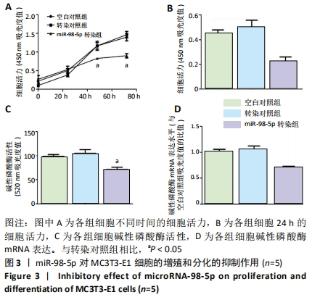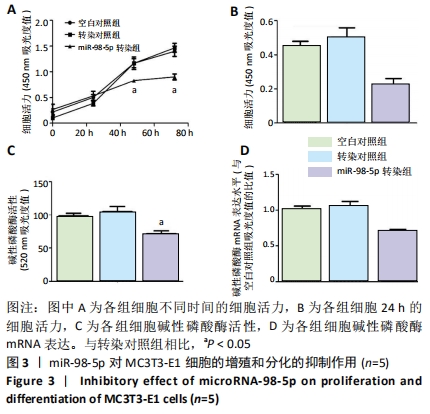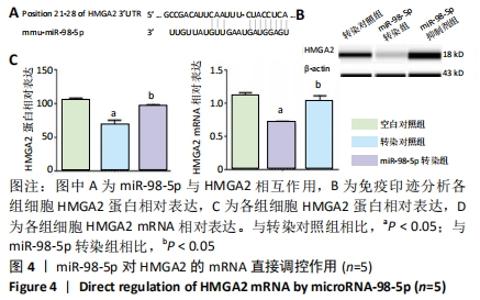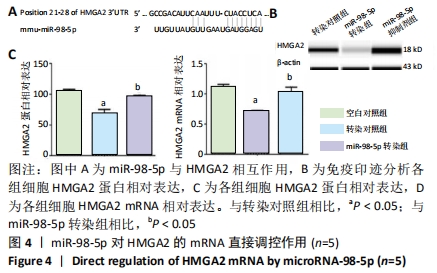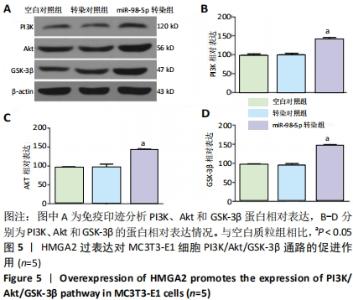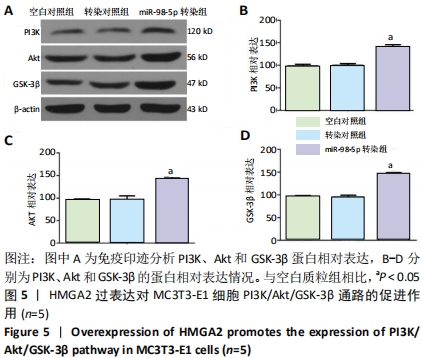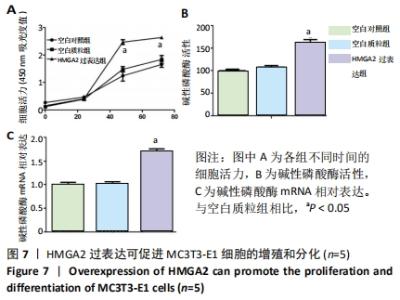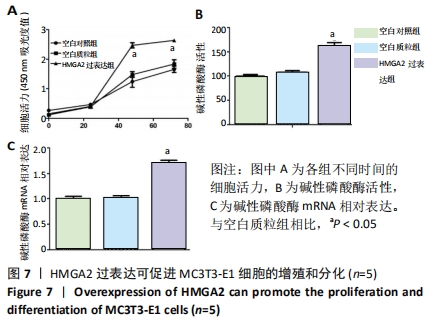Chinese Journal of Tissue Engineering Research ›› 2021, Vol. 25 ›› Issue (26): 4112-4117.doi: 10.12307/2021.107
Previous Articles Next Articles
MicroRNA-98-5p promotes osteoblast proliferation and differentiation: possibilities and mechanisms
Zheng Feng, Zhang Fucai, Xu Zhe
- Department of Orthopedics, Qinghai Provincial People’s Hospital, Xining 810007, Qinghai Province, China
-
Received:2020-09-11Revised:2020-09-12Accepted:2020-10-30Online:2021-09-18Published:2021-04-19 -
Contact:Zheng Feng, Department of Orthopedics, Qinghai Provincial People’s Hospital, Xining 810007, Qinghai Province, China -
About author:Zheng Feng, Master, Chief physician, Department of Orthopedics, Qinghai Provincial People’s Hospital, Xining 810007, Qinghai Province, China -
Supported by:the Basic Research Plan of Qinghai Province, No. 2020-ZJ-755 (to ZF)
CLC Number:
Cite this article
Zheng Feng, Zhang Fucai, Xu Zhe. MicroRNA-98-5p promotes osteoblast proliferation and differentiation: possibilities and mechanisms[J]. Chinese Journal of Tissue Engineering Research, 2021, 25(26): 4112-4117.
share this article
Add to citation manager EndNote|Reference Manager|ProCite|BibTeX|RefWorks
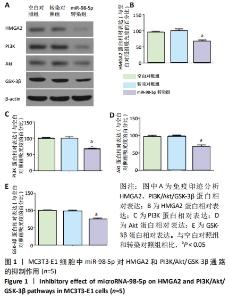
2.1 miR-98-5p模拟物对MC3T3-E1细胞HMGA2和PI3K/Akt/GSK-3β通路的影响 为研究miR-98-5p在MC3T3-E1细胞中对HMGA2和PI3K/Akt/GSK-3β通路的影响,采用miR-98-5p模拟物,在诱导成骨细胞MC3T3-E1分化后,空白对照组和转染对照组的HMGA2和PI3K/Akt/GSK-3β差异无显著变化(P > 0.05),与转染对照组相比,miR-98-5p转染组的HMGA2和PI3K/Akt/GSK-3β蛋白显著降低(P < 0.05),见图1。表明 miR-98-5p可显著抑制成骨细胞MC3T3-E1的HMGA2蛋白表达,同时抑制PI3K/Akt/GSK-3β通路。"
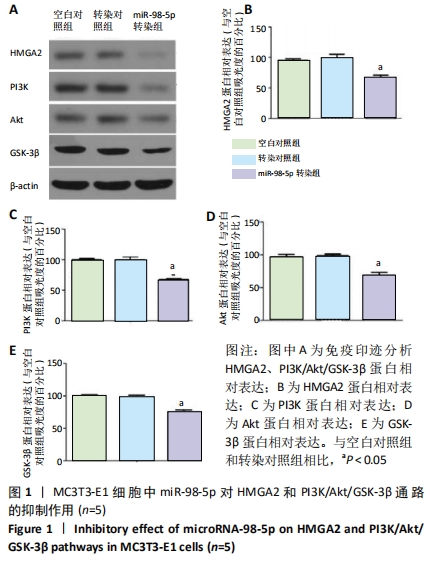
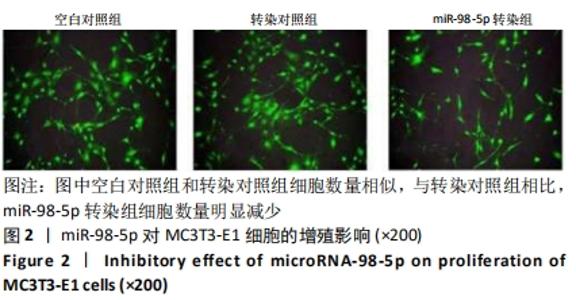
2.2 miR-98-5p模拟物可显著抑制MC3T3-E1细胞的增殖和分化 为探讨miR-98-5p对MC3T3-E1细胞的增殖和分化的影响,成功构建了miR-98-5p转染细胞。用CCK-8检测细胞增殖,空白对照组和转染对照组细胞数量差异无显著性意义 (P > 0.05),与转染对照组相比,miR-98-5p转染组细胞数量显著降低(P < 0.05),见图2。荧光显微镜下观察成骨细胞分化,发现0 h和24 h时各组细胞分化程度差异无显著性意义(P > 0.05),空白对照组和转染对照组48 h和72 h细胞分化程度差异无显著性意义(P > 0.05),与转染对照组相比,miR-98-5p转染组的分化程度显著降低(P < 0.05)。空白对照组和转染对照组MC3T3-E1细胞的增殖差异无显著性意义(P > 0.05),与转染对照组相比,miR-98-5p 转染组MC3T3-E1细胞的增殖明显降低 (P < 0.05)。空白对照组和转染对照组成骨细胞增殖标记物碱性磷酸酶活性及mRNA差异无显著性意义(P > 0.05);与转染对照组相比,miR-98-5p转染组碱性磷酸酶活性及mRNA显著降低(P < 0.05)。见图3。这些研究表明miR-98-5p可显著抑制成骨细胞MC3T3-E1的增殖和分化。"
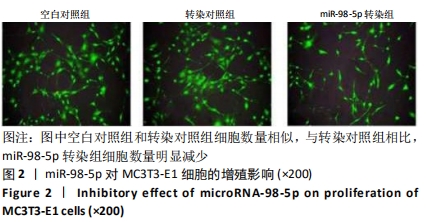
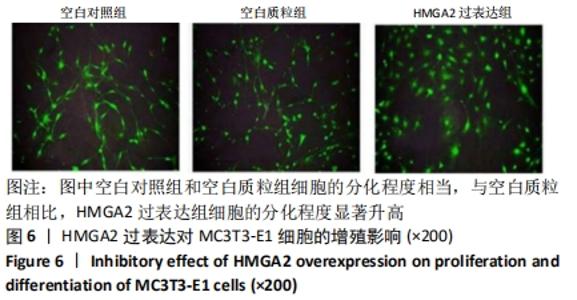
2.5 HMGA2过表达可显著抑制MC3T3-E1细胞的增殖和分化 研究表明,miR-98-5p可抑制HMGA2蛋白表达,HMGA2可增强PI3K/Akt通路[15],同时还可抑制成骨细胞的增殖分化[16]。MC3T3-E1细胞过表达HMGA2可增强PI3K/Akt/GSK-3β通路。为考察HMGA2过表达对成骨细胞增殖和分化的影响,以荧光显微镜观察,在0 h和24 h各组成骨细胞分化差异无显著意义(P > 0.05),空白对照组和空白质粒组48 h和72 h时成骨细胞分化接近(P > 0.05),与空白质粒组相比,HMGA2过表达组细胞的分化程度显著升高(P < 0.05)。成骨细胞增殖检测结果表明,空白对照组和空白质粒组增殖程度差异无显著性意义(P > 0.05),与空白质粒组相比,HMGA2过表达组细胞增殖明显增加(P < 0.05)。空白对照组和空白质粒组的碱性磷酸酶活性和mRNA差异无显著性意义(P > 0.05),与空白质粒组相比,HMGA2过表达组碱性磷酸酶活性和mRNA表达明显增加(P < 0.05),见图6和7。"
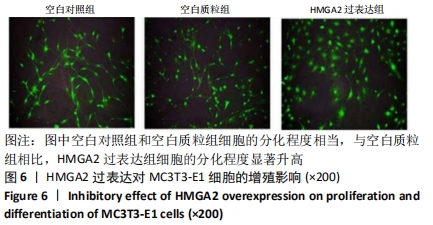
| [1] Qiao Z, Greven J, Horst K, et al. Fracture Healing and the Underexposed Role of Extracellular Vesicle-Based Cross Talk. Shock. 2018;49(5):486-496. [2] Bergdolt S, Kovtun A, Hägele Y, et al. Osteoblast-specific overexpression of complement receptor C5aR1 impairs fracture healing. PLoS One. 2017;12(6):e0179512. [3] Sekiguchi Y, Mano H, Nakatani S, et al. Mangiferin positively regulates osteoblast differentiation and suppresses osteoclast differentiation. Mol Med Rep. 2017;16(2):1328-1332. [4] Chen X, Wang Z, Duan N, et al. Osteoblast-osteoclast interactions. Connect Tissue Res. 2018;59(2):99-107. [5] Jiao H, Xiao E, Graves DT. Diabetes and Its Effect on Bone and Fracture Healing. Curr Osteoporos Rep. 2015;13(5):327-335. [6] Prideaux M, Findlay DM, Atkins GJ. Osteocytes: The master cells in bone remodelling. Curr Opin Pharmacol. 2016;28:24-30. [7] LEE WC, GUNTUR AR, LONG F, et al. Energy Metabolism of the Osteoblast: Implications for Osteoporosis. Endocr Rev. 2017;38(3):255-266. [8] Ghiasi MS, Chen J, Vaziri A, et al. Bone fracture healing in mechanobiological modeling: A review of principles and methods. Bone Rep. 2017;6:87-100. [9] Piccoli MT, Gupta SK, Thum T. Noncoding RNAs as regulators of cardiomyocyte proliferation and death. J Mol Cell Cardiol. 2015;89(Pt A):59-67. [10] Han T, Wu N, Wang Y, et al. miR‑16‑2‑3p inhibits cell proliferation and migration and induces apoptosis by targeting PDPK1 in maxillary primordium mesenchymal cells. Int J Mol Med. 2019;43(3):1441-1451. [11] Zhang M, Wang F, Zhang X. miRNA-627 inhibits cell proliferation and cell migration, promotes cell apoptosis in prostate cancer cells through upregulating MAP3K1, PTPRK and SRA1. Int J Clin Exp Pathol. 2018;11(1):255-261. [12] Qiu K, Xie Q, Jiang S, et al. miR-98-5p promotes apoptosis and inhibits migration and cell growth in papillary thyroid carcinoma through Bax/Caspase-3 by HMGA2. J Clin Lab Anal. 2020;34(2):e23044. [13] Ma P, Gu B, Xiong W, et al. Glimepiride promotes osteogenic differentiation in rat osteoblasts via the PI3K/Akt/eNOS pathway in a high glucose microenvironment. PLoS One. 2014;9(11):e112243. [14] Majidinia M, Sadeghpour A, Yousefi B. The roles of signaling pathways in bone repair and regeneration. J Cell Physiol. 2018;233(4): 2937-2948. [15] Zhu Y, Xu J, Liang W, et al. miR-98-5p Alleviated Epithelial-to-Mesenchymal Transition and Renal Fibrosis via Targeting Hmga2 in Diabetic Nephropathy. Int J Endocrinol. 2019;2019:4946181. [16] Yuan H, Zhao H, Wang J, et al. MicroRNA let-7c-5p promotes osteogenic differentiation of dental pulp stem cells by inhibiting lipopolysaccharide-induced inflammation via HMGA2/PI3K/Akt signal blockade. Clin Exp Pharmacol Physiol. 2019;46(4):389-397. [17] Hu C, Zhang T, Ren B, et al. Effect of vacuum-assisted closure combined with open bone grafting to promote rabbit bone graft vascularization. Med Sci Monit. 2015;21:1200-1206. [18] Hammond SM. An overview of microRNAs. Adv Drug Deliv Rev. 2015; 87:3-14. [19] Soifer HS, Rossi JJ, Saetrom P. MicroRNAs in disease and potential therapeutic applications. Mol Ther. 2007;15(12):2070-2079. [20] Krol J, Loedige I, Filipowicz W. The widespread regulation of microRNA biogenesis, function and decay. Nat Rev Genet. 2010;11(9): 597-610. [21] Tang J, Zhang Z, Jin X, et al. miR-383 negatively regulates osteoblastic differentiation of bone marrow mesenchymal stem cells in rats by targeting Satb2. Bone. 2018;114:137-143. [22] Arfat Y, Basra MAR, Shahzad M, et al. miR-208a-3p Suppresses Osteoblast Differentiation and Inhibits Bone Formation by Targeting ACVR1. Mol Ther Nucleic Acids. 2018;11:323-336. [23] Zhang L, Tang Y, Zhu X, et al. Overexpression of MiR-335-5p Promotes Bone Formation and Regeneration in Mice. J Bone Miner Res. 2017; 32(12):2466-2475. [24] Kureel J, John AA, Dixit M, et al. MicroRNA-467g inhibits new bone regeneration by targeting Ihh/Runx-2 signaling. Int J Biochem Cell Biol. 2017;85:35-43. [25] Zhang Y, Gao Y, Cai L, et al. MicroRNA-221 is involved in the regulation of osteoporosis through regulates RUNX2 protein expression and osteoblast differentiation. Am J Transl Res. 2017;9(1):126-135. [26] Chen G, Deng C, Li YP. TGF-β and BMP signaling in osteoblast differentiation and bone formation. Int J Biol Sci. 2012;8(2):272-288. [27] Bertacchini J, Heidari N, Mediani L, et al. Targeting PI3K/AKT/mTOR network for treatment of leukemia. Cell Mol Life Sci. 2015; 72(12):2337-2347. [28] Manfredi GI, Dicitore A, Gaudenzi G, et al. PI3K/Akt/mTOR signaling in medullary thyroid cancer: a promising molecular target for cancer therapy. Endocrine. 2015;48(2):363-370. [29] Wang J, Ma XY, Feng YF, et al. Magnesium Ions Promote the Biological Behaviour of Rat Calvarial Osteoblasts by Activating the PI3K/Akt Signalling Pathway. Biol Trace Elem Res. 2017;179(2):284-293. [30] Ma P, Gu B, Ma J, et al. Glimepiride induces proliferation and differentiation of rat osteoblasts via the PI3-kinase/Akt pathway. Metabolism. 2010;59(3):359-366. [31] Phukan S, Babu VS, Kannoji A, et al. GSK3beta: role in therapeutic landscape and development of modulators. Br J Pharmacol. 2010; 160(1):1-19. [32] Guo B, Zhang W, Xu S, et al. GSK-3β mediates dexamethasone-induced pancreatic β cell apoptosis. Life Sci. 2016;144:1-7. [33] Sharma M, Chuang WW, Sun Z. Phosphatidylinositol 3-kinase/Akt stimulates androgen pathway through GSK3beta inhibition and nuclear beta-catenin accumulation. J Biol Chem. 2002;277(34):30935-30941. [34] Yao CJ, Lv Y, Zhang CJ, et al. MicroRNA-185 inhibits the growth and proliferation of osteoblasts in fracture healing by targeting PTH gene through down-regulating Wnt/β -catenin axis: In an animal experiment. Biochem Biophys Res Commun. 2018;501(1):55-63. [35] Song F, Jiang D, Wang T, et al. Mechanical Stress Regulates Osteogenesis and Adipogenesis of Rat Mesenchymal Stem Cells through PI3K/Akt/GSK-3β/β-Catenin Signaling Pathway. Biomed Res Int. 2017;2017:6027402. [36] Zheng X, Dai J, Zhang H, et al. MicroRNA-221 promotes cell proliferation, migration, and differentiation by regulation of ZFPM2 in osteoblasts. Braz J Med Biol Res. 2018;51(12):e7574. [37] Zheng F, Wang F, Xu Z. MicroRNA-98-5p prevents bone regeneration by targeting high mobility group AT-Hook 2. Exp Ther Med. 2019;18(4): 2660-2666. [38] 刘珍星,张山锋,杨钟华.IL-38通过调控PI3K/Akt/GSK3β/NFATc1信号通路抑制骨质疏松的机制研究[J].中国免疫学杂志,2018,34(2): 251-255. [39] Guo Z, He C, Yang F, et al. Long non-coding RNA-NEAT1, a sponge for miR-98-5p, promotes expression of oncogene HMGA2 in prostate cancer. Biosci Rep. 2019;39(9):BSR20190635. |
| [1] | Geng Yao, Yin Zhiliang, Li Xingping, Xiao Dongqin, Hou Weiguang. Role of hsa-miRNA-223-3p in regulating osteogenic differentiation of human bone marrow mesenchymal stem cells [J]. Chinese Journal of Tissue Engineering Research, 2021, 25(7): 1008-1013. |
| [2] | Li Cai, Zhao Ting, Tan Ge, Zheng Yulin, Zhang Ruonan, Wu Yan, Tang Junming. Platelet-derived growth factor-BB promotes proliferation, differentiation and migration of skeletal muscle myoblast [J]. Chinese Journal of Tissue Engineering Research, 2021, 25(7): 1050-1055. |
| [3] | Liu Cong, Liu Su. Molecular mechanism of miR-17-5p regulation of hypoxia inducible factor-1α mediated adipocyte differentiation and angiogenesis [J]. Chinese Journal of Tissue Engineering Research, 2021, 25(7): 1069-1074. |
| [4] | Wang Shiqi, Zhang Jinsheng. Effects of Chinese medicine on proliferation, differentiation and aging of bone marrow mesenchymal stem cells regulating ischemia-hypoxia microenvironment [J]. Chinese Journal of Tissue Engineering Research, 2021, 25(7): 1129-1134. |
| [5] | Ma Zetao, Zeng Hui, Wang Deli, Weng Jian, Feng Song. MicroRNA-138-5p regulates chondrocyte proliferation and autophagy [J]. Chinese Journal of Tissue Engineering Research, 2021, 25(5): 674-678. |
| [6] | Liu Bo, Chen Xianghe, Yang Kang, Yu Huilin, Lu Pengcheng. Mechanism of DNA methylation in exercise intervention for osteoporosis [J]. Chinese Journal of Tissue Engineering Research, 2021, 25(5): 791-797. |
| [7] | Deng Zhenhan, Huang Yong, Xiao Lulu, Chen Yulin, Zhu Weimin, Lu Wei, Wang Daping. Role and application of bone morphogenetic proteins in articular cartilage regeneration [J]. Chinese Journal of Tissue Engineering Research, 2021, 25(5): 798-806. |
| [8] | Wang Yujiao, Liu Dan, Sun Song, Sun Yong. Biphasic calcium phosphate loaded with advanced platelet rich fibrin can promote the activity of rabbit bone marrow mesenchymal stem cells [J]. Chinese Journal of Tissue Engineering Research, 2021, 25(4): 504-509. |
| [9] | Zhou Jihui, Yao Meng, Wang Yansong, Li Xinzhi, Zhou You, Huang Wei, Chen Wenyao. Influence of novel nanoscaffolds on biological behaviors of neural stem cells and the related gene expression [J]. Chinese Journal of Tissue Engineering Research, 2021, 25(4): 532-536. |
| [10] | Ye Haimin, Ding Linghua, Kong Weihao, Huang Zutai, Xiong Long. Role and mechanism of hierarchical microchanneled bone scaffolds in promoting osteogenesis and angiogenesis [J]. Chinese Journal of Tissue Engineering Research, 2021, 25(4): 621-625. |
| [11] | Li Jun, Zuo Xinhui, Liu Xiaoyuan, Zhang Kai, Han Xiangzhen, He Huiyu, . Effect of over expression of miR-378a on osteogenic and vascular differentiation of bone marrow mesenchymal stem cell sheet [J]. Chinese Journal of Tissue Engineering Research, 2021, 25(31): 4939-4944. |
| [12] | Li Junqing, He Wenxi, Guo Qian, Wu Jiayuan. Effect of hydrostatic pressure on odontogenic/osteogenic differentiation of dental pulp stem cells [J]. Chinese Journal of Tissue Engineering Research, 2021, 25(31): 4976-4980. |
| [13] | Liu Lei, Di Haiping, Guo Haina, Cao Dayong, Niu Xihua, Xia Chengde. Changes in biological characteristics of platelet-rich fibrin by freeze-drying technology [J]. Chinese Journal of Tissue Engineering Research, 2021, 25(31): 4995-4999. |
| [14] | Wei Congcong, Yao Mengxuan, Yang Meng, Li Huijie. Mechanism and treatment of osteolysis around artificial joint prosthesis [J]. Chinese Journal of Tissue Engineering Research, 2021, 25(27): 4401-4407. |
| [15] | Cheng Ning, Zhang Zhizhong. Regulatory effects of LncRNA MEG3 on the proliferation and apoptosis of nucleus pulposus cells in rat intervertebral disc [J]. Chinese Journal of Tissue Engineering Research, 2021, 25(26): 4106-4111. |
| Viewed | ||||||
|
Full text |
|
|||||
|
Abstract |
|
|||||
